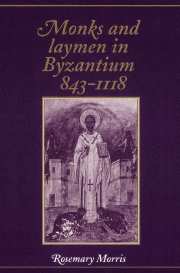Book contents
- Frontmatter
- Contents
- List of maps
- List of tables
- Acknowledgements
- Note on transliteration and citation
- List of abbreviations
- Introduction
- PART I FOUNDERS AND BENEFACTORS
- PART II PROTECTION AND SURVIVAL
- 6 Monasteries and the law
- 7 Fortune and misfortune
- 8 Territorial expansion and spiritual compromise
- 9 The challenge to central authority
- 10 The Komnene reaction
- Appendix: Imperial privileges to monasteries, c. 900–1118
- Bibliography
- Index
9 - The challenge to central authority
from PART II - PROTECTION AND SURVIVAL
Published online by Cambridge University Press: 10 December 2009
- Frontmatter
- Contents
- List of maps
- List of tables
- Acknowledgements
- Note on transliteration and citation
- List of abbreviations
- Introduction
- PART I FOUNDERS AND BENEFACTORS
- PART II PROTECTION AND SURVIVAL
- 6 Monasteries and the law
- 7 Fortune and misfortune
- 8 Territorial expansion and spiritual compromise
- 9 The challenge to central authority
- 10 The Komnene reaction
- Appendix: Imperial privileges to monasteries, c. 900–1118
- Bibliography
- Index
Summary
By the end of the eleventh century, the estates of the great monasteries had evolved into powerful economic units. In some areas, the extent of their lands put them on a par with the lay aristocracy, and, unlike them, they enjoyed peculiar advantages. Although they might be subject to the same ravages of climate and the same difficulties of geography, their estates were rarely subject to confiscation for political reasons or subject to the demands of inheritance. Abundant supplies of cash and labour enabled them to expand and to play an important part in the economic life not only of the neighbouring regions, but also further afield. Lay patronage fuelled monastic development and imperial support in particular was a crucial factor in transforming self-sufficient monasteries into highly profitable ones. The motives of piety, patronage and personal friendship which lay behind this generosity have already been discussed. But what were the political and economic consequences of such actions? The question that has to be asked is a simple one, although it has many ramifications: given the difficulties of ensuring the power of the central government over an empire of such extent and ethnic variety, did the existence of stable and economically powerful monastic units within the Byzantine state compound the problems of administration and give a further dimension to the already existing problems of regionalism? And if this was the case, how could the power of the organs of central government, both lay and ecclesiastical, be reasserted over them?
- Type
- Chapter
- Information
- Monks and Laymen in Byzantium, 843–1118 , pp. 241 - 266Publisher: Cambridge University PressPrint publication year: 1995



